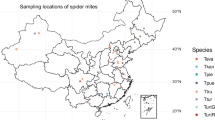Abstract
Arthropods are associated with various microorganisms which confer benefits to their hosts. Recently, research has been conducted on bacterial communities of insects to provide an insight into the potential interactions of the symbiotic bacteria and their hosts. Spiders are interesting to study as they are perceived to be natural enemies of pests. The effect of endosymbionts on spiders has been reported, but little is known about the overall bacterial communities present in spiders. Here, we report on the characterization of bacterial communities present in the whole body of the spider Marpiss magister using Illumina sequencing of 16S rRNA amplicons. Our study shows that the most abundant phyla of bacteria included Proteobacteria, Tenericutes, Bacteroidetes and Actinobacteria. At the genus level, the most abundant genera included Rickettsia, Wolbachia, Spiroplasma, and Cardinium. Besides these dominant endosymbionts, our study also showed the existence of bacteria in the genera Arthrobacter, Novosphingobium, Acinetobacter, Pseudomonas, Aquabacterium and Sphingomonas at an abundance ranging from 0.65 to 0.84%, and the existence of bacterial in genera Lactobacillus, Sphingobium, Methylobacterium, Bradyrhizobium, Propionibacterium, Brevundimonas, Achromobacter, Microbacterium, Corynebacterium, and Flavobacterium at a slightly lower abundance ranging from 0.1 to 0.5%. Therefore, our finding indicates that endosymbionts are not the only microbiota present in the spider M. magister, and other bacterial taxa also exist in its bacterial community.


Similar content being viewed by others
References
Anjum SI, Shah AH, Aurongzeb M, Kori J, Azim MK, Ansari MJ, Bin L (2017) Characterization of gut bacterial flora of Apis mellifera from North-West Pakistan. Saudi J Biol Sci. doi:10.1016/j.sjbs.2017.05.008
Bili M, Cortesero AM, Mougel C, Gauthier JP, Ermel G, Simon JC, Outreman Y, Terrat S, Mahéo F, Poinsot D (2016) Bacterial community diversity harboured by interacting species. PLoS One. doi:10.1371/journal.pone.0155392
Bolger AM, Lohse M, Usadel B (2014) Trimmomatic: a flexible trimmer for Illumina sequence data. Bioinformatics 30:2114–2120
Brownlie JC, Cass BN, Riegler M, Witsenburg JJ, Iturbe-Ormaetxe I, McGraw EA, O’Neill SL (2009) Evidence for metabolic provisioning by a common invertebrate endosymbiont, Wolbachia pipientis, during periods of nutritional stress. PLoS Pathog. doi:10.1371/journal.ppat.1000368
Caporaso JG, Lauber CL, Walters WA et al (2012) Ultra-high-throughput microbial community analysis on the Illumina HiSeq and MiSeq platforms. ISME J 6:1621–1624
Cole JR, Wang Q, Cardenas E, Fish J, Chai B, Farris RJ, Kulam-Syed-Mohideen AS, McGarrell DM, Marsh T, Garrity GM, Tiedje JM (2009) The ribosomal database project: improved alignments and new tools for rRNA analysis. Nucleic Acids Res 37:141–145
Duron O, Hurst GDD, Hornett EA, Josling JA, Engelstädter J (2008) High incidence of the maternally inherited bacterium Cardinium in spiders. Mol Ecol 17:1427–1437
Edgar RC (2010) Search and clustering orders of magnitude faster than BLAST. Bioinformatics 26:2460–2461
Edgar RC, Haas BJ, Clemente JC, Quince C, Knight R (2011) UCHIME improves sensitivity and speed of chimera detection. Bioinformatics 27:2194–2200
Edwards RL, Edwards EH, Edwards AD (2003) Observations of Theotima minutissimus (Araneae; Ochyroceratidae), a parthenogenetic spider. J Arachnol 31:274–277
Engel P, Moran NA (2013) The gut microbiota of insects—diversity in structure and function. FEMS Microbiol Rev 37:699–735
Fryxell RTT, DeBruyn JM (2016) The microbiome of Ehrlichia-infected and uninfected lone star ticks (Amblyomma americanum). PLoS One. doi:10.1371/journal.pone.0146651
Goodacre SL, Martin OY, Thomas CFG, Hewitt GM (2006) Wolbachia and other endosymbiont infections in spiders. Mol Ecol 15:517–527
Gotoh T, Noda H, Ito S (2007) Cardinium symbionts cause cytoplasmic incompatibility in spider mites. Heredity 98:13–20
Gupta AK, Rastogi G, Nayduch D, Sawant SS, Bhonde RR, Shouche YS (2014) Molecular phylogenetic profiling of gut-associated bacteria in larvae and adults of flesh flies. Med Vet Entomol 28:345–354
Himler AG, Adachi-Hagimori T, Bergen JE, Kozuch A, Kelly SE, Tabashnik BE, Chiel E, Duckworth VE, Dennehy TJ, Zchori-Fein E, Hunter MS (2011) Rapid spread of a bacterial symbiont in an invasive whitefly is driven by fitness benefits and female bias. Science 332:254–256
Kozich JJ, Westcott SL, Baxter NT, Highlander SK, Schloss PD (2013) Development of a dual-index sequencing strategy and curation pipeline for analyzing amplicon sequence data on the MiSeq Illumina sequencing platform. Appl Environ Microbiol 79:5112–5120
Magoč T, Salzberg SL (2011) FLASH: fast length adjustment of short reads to improve genome assemblies. Bioinformatics 27:2957–2963
Martin OY, Goodacre SL (2009) Widespread infections by the bacterial endosymbiont Cardinium in arachnids. J Arachnol 37:106–108
Masta SE, Maddison WP (2002) Sexual selection driving diversification in jumping spiders. Proc Natl Acad Sci USA 99:4442–4447
Monteiro CC, Villegas LEM, Campolina TB, Pires AC, Miranda JC, Pimenta PF, Secundino NF (2016) Bacterial diversity of the American sand fly Lutzomyia intermedia using high-throughput metagenomic sequencing. Parasit Vectors 9:480
Quast C, Pruesse E, Yilmaz P, Gerken J, Schweer T, Yarza P, Peplies J, Glöckner FO (2013) The SILVA ribosomal RNA gene database project: improved data processing and web-based tools. Nucleic Acids Res 41:590–596
Snyman M, Gupta AK, Bezuidenhout CC, Claassens S, Van den Berg J (2016) Gut microbiota of Busseola fusca (Lepidoptera: Noctuidae). World J Microbiol Biotechnol 32:1–9
Vanthournout B, Hendrickx F (2015) Endosymbiont dominated bacterial communities in a dwarf spider. PLoS One. doi:10.1371/journal.pone.0117297
Vanthournout B, Vandomme V, Hendrickx F (2014) Sex ratio bias caused by endosymbiont infection in the dwarf spider Oedothorax retusus. J Arachnol 42:24–33
Wang Y, Gilbreath TM III, Kukutla P, Yan G, Xu J (2011) Dynamic gut microbiome across life history of the malaria mosquito Anopheles gambiae in Kenya. PLoS One. doi:10.1371/journal.pone.0024767
Acknowledgements
This work was supported by the National Natural Science Fund of China (31401982, 31672317) and the Key Scientific and Technological Projects of Hubei (2016AHB003).
Author information
Authors and Affiliations
Contributions
Yueli Yun and Guimin Zhang designed the experiments. Lihua Zhang, Yueli Yun and Yu Peng conducted the experiments and data analysis. Yueli Yun and Lihua Zhang wrote the manuscript.
Corresponding author
Ethics declarations
Conflict of interest
All the authors declare that they have no conflict of interest in the publication.
Rights and permissions
About this article
Cite this article
Zhang, L., Zhang, G., Yun, Y. et al. Bacterial community of a spider, Marpiss magister (Salticidae). 3 Biotech 7, 371 (2017). https://doi.org/10.1007/s13205-017-0994-0
Received:
Accepted:
Published:
DOI: https://doi.org/10.1007/s13205-017-0994-0




